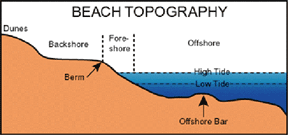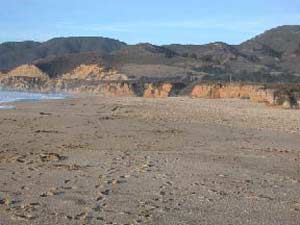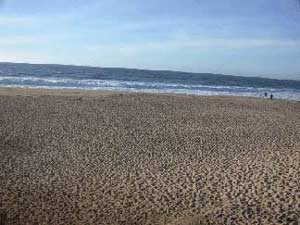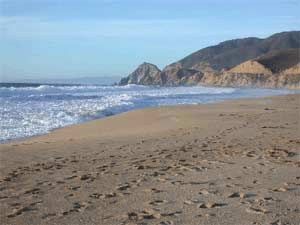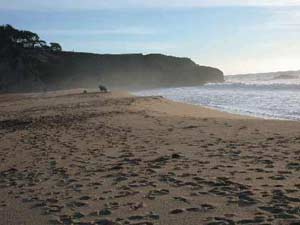|
|
return to
|
||||||||||
Wave Action:
A Virtual Exploration of the Beach |
|||||||||||
Focus Question: What are some of the main divisions of the beach?Important parts of the beach include:
Focus Question: How does energy vary along the beach area?Beaches are dynamic, ever-changing environments where wave energy varies constantly. In the summer months when lower energy waves push sand from the offshore bar to the beach face, a steeper beach face occurs. http://geoserv.geology.wmich.edu/kominz/C12beach.gif Generally speaking in the backshore environment, the wave energy is less because the waves only reach this area during the highest tides and the strongest winter waves. Sediment deposited here is close to the source, as it’s mostly derived from the sea cliffs and upland areas and is less likely to be removed. The higher energy in the foreshore environment more effectively scours this area of the beach, especially during the high winter waves. This process removes a significant amount of sand to the offshore bars, resulting in a flatter beach face and a higher berm during the winter months. Focus Question: How does sediment grain size vary along the beach in response to wave energy?Examine the series of photos from Montara Beach below. They compare the backshore and foreshore areas. What are some differences that you notice from the photographs?
Focus Question: How does sediment grain size vary along the beach in response to wave energy?Along the foreshore environment, the higher energy removes sand, including the coarsest sand on the beach. This process of erosion leaves behind a greater amount of fine sand compared to the backshore environment. Along the backshore environment, there is lower wave energy and therefore there is less potential to remove sand. As a result, a greater amount of the coarse beach sand accumulates in the the backshore environment. Teachers examined grain size variation in sediment collected from two areas of Montara Beach in the activity Exploring the Sands. Additional Resources:An overview of beaches may be found on https://ucmp.berkeley.edu/education/calandscape/session4/beaches6.html For an illustrated diagram of beach dynamics, link to http://geoserv.geology.wmich.edu/kominz/C12beach.gif Additional information about beach habitats may be found on http://www.onr.navy.mil/focus/ocean/habitats/beaches1.htm |
|||||||||||
|
Return to: Potential to Kinetic | Dynamic Earth Homepage | UCMP Homepege |
|||||||||||
